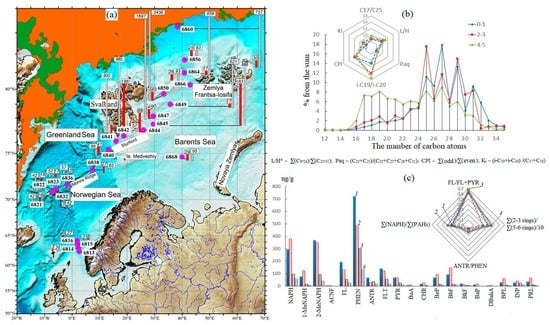Features of the Hydrocarbon Distribution in the Bottom Sediments of the Norwegian and Barents Seas
Abstract
:1. Introduction
2. Methods of the Studies
3. Results
3.1. 2019 (The 75th Cruise of the R/V Akademik Mstislav Keldysh)
3.2. 2020 (The 80th Cruise of the R/V Akademik Mstislav Keldysh)
4. Discussion
5. Conclusions
Supplementary Materials
Author Contributions
Funding
Institutional Review Board Statement
Informed Consent Statement
Data Availability Statement
Acknowledgments
Conflicts of Interest
References
- Kaminskiy, V.D.; Suprunenko, O.I.; Smirnov, A.N.; Medvedeva, T.Y.; Chernykh, A.A.; Aleksandrova, A.G. The current resource state and prospects for the development of the mineral resource base of the shelf region of the Russian Arctic. Explor. Conserv. Miner. Resour. 2016, 9, 136–142. (In Russian) [Google Scholar]
- Grigorenko, Y.N. Oil accumulation zones as an object of study and forecast Oil and gas geology. Theory Pract. 2016, 11, 1–11. Available online: http://www.ngtp.ru/rub/6/49_2016.pdf (accessed on 9 November 2021).
- Tissot, B.; Welte, D. Petroleum Formation and Occurrence; Springer: Berlin, Germany, 1984; p. 699. [Google Scholar]
- Pechora Sea. System Research Experience; RFFI: Moscow, Russia, 2003; p. 486. (In Russian) [Google Scholar]
- Nemirovskaya, I.A. Oil in the Ocean (Pollution and Natural Flows); Nauchnyy Mir: Moscow, Russia, 2013; p. 432. (In Russian) [Google Scholar]
- Petrova, V.I.; Batova, G.I.; Kursheva, A.V.; Litvinenko, I.V.; Morgunova, I.P. Hydrocarbons in bottom sediments of the Shtokman area—Distribution, genesis, time trends. Neftegazov. Geologiya. Theory Pract. 2015, 10, 1–21. [Google Scholar]
- AMAP (Arctic Monitoring and Assessment Programme). Chapter 4. Sources, Inputs and Concentrations of Petroleum Hydrocarbons, Polycyclic Aromatic Hydrocarbons, and Other Contaminants Related to Oil and Gas Activities in the Arctic; AMAP Assessment: Oslo, Norway, 2007; Volume 4, p. 87. [Google Scholar]
- NAS (National Academy of Sciences). Oil in the Sea III: Inputs, Fates, and Effects; National Research Council; The National Academies Press: Washington, DC, USA, 2003; p. 265. [Google Scholar]
- Yunker, M.B.; Macdonald, R.W.; Ross, P.S.; Sophia, C.; Johannessen, B.; Neil, D. Alkane and PAH provenance and potential bioavailability in coastal marine sediments subject to a gradient of anthropogenic sources in British Columbia, Canada. Org. Geochem. 2015, 89–90, 80–116. [Google Scholar] [CrossRef]
- Lisitzyn, A.P. Dispersed sedimentary matter in the Earth’s geospheres and in the White Sea system. White Sea. M. Sci. World 2012, 2, 19–47. [Google Scholar]
- Kontorovich, A.E.; Borisova, L.S. Composition of asphaltenes as an indicator of the type of dispersed organic matter. Geochemistry 1994, 11, 1660–1667. [Google Scholar]
- AMAP (Arctic Monitoring and Assessment Programme). Chemicals of Emerging Arctic Concern; AMAP Assessment: Oslo, Norway, 2017; p. 353. [Google Scholar]
- Klyuvitkin, A.A.; Kravchishina, M.D.; Nemirovskaya, I.A.; Baranov, B.V.; Kochenkova, A.I.; Lisitzin, A.P. Studies of the sediment systems of the European Arctic during the cruise 75 of the R/V Akademik Mstislav Keldysh. Oceanology 2020, 60, 485–487. [Google Scholar] [CrossRef]
- Klyuvitkin, A.A.; Politova, N.V.; Novigatsky, A.N.; Kravchishina, M.D. Studies of the European Arctic during the 80th Cruise of the Research Vessel Akademik Mstislav Keldysh. Oceanology 2021, 61, 139–141. [Google Scholar] [CrossRef]
- Kravchishina, M.D.; Novigatsky, A.N.; Savvichev, A.S.; Pautova, L.A.; Lisicin, A.P. Investigation of sediment systems of the Barents Sea and the Norwegian-Greenland basin during the 68th voyage of the research vessel “Akademik Mstislav Keldysh”. Oceanology 2019, 59, 173–176. [Google Scholar] [CrossRef]
- Nemirovskaya, I.A. Hydrocarbons in the waters and bottom sediments of the Barents Sea during the period of ice cover variability. Geokhimiya 2020, 65, 679–692. [Google Scholar]
- Korshenko, A. Marine Water Pollution; Annual Report 2019; Nauka: Moscow, Russia, 2020; p. 190. [Google Scholar]
- Simard, R.; Hasegawa, J.; Bandaruk, W.; Headington, C.E. Infrared spectrometric determination of oil and phenol in water. Anal. Chem. 1951, 23, 1384–1387. [Google Scholar] [CrossRef]
- Monitoring of Hhazardous Substances in the White Sea and Pechora Sea; Harmonisation with OSPAR’s Coordinated Environmental Monitoring Programme (CEMP); Akvaplan-Niva: Tromsø, Norway, 2011; p. 71.
- Nemirovskaya, I.A. Content and composition of hydrocarbons in water, suspended matter and bottom sediments of the Kara Sea. Oceanology 2010, 50, 717–729. [Google Scholar] [CrossRef]
- Tarasov, G.A. Quaternary sedimentary cover of the western arctic shelf: Lithological structure, spatial distribution. Vestnik KSC RAS 2015, 21, 124–134. (In Russian) [Google Scholar]
- Nemirovskaya, I.A. Oil units on the beaches of the Baltic Sea. Water Resour. 2011, 3, 315–323. [Google Scholar] [CrossRef]
- Yamamoto, M.; Polyak, L. Changes in terrestrial organic matter input to the Mendeleev Ridge, western Arctic Ocean, during the Late Quaternary. Glob. Planet. Chang. 2009, 68, 30–37. [Google Scholar] [CrossRef] [Green Version]
- Kashirtsev, V.A. Organic Geochemistry of Naphthides in the East of the Siberian Platform; YF. SO RAN: Yakutsk, Russia, 2003; p. 160. [Google Scholar]
- Fernandes, M.B.; Sicre, M.A. The importance of terresrial organic carbon inputs on Kara Sea shelves as revealed by n-alkanes, OC and δ13C values. Org. Geochem. 2000, 31, 363–374. [Google Scholar] [CrossRef]
- Tolosa, I.; Mora, S.; Sheikholeslami, M.R.; Villeneuve, J.; Bartocci, J.; Cattini, C. Aliphatic and Aromatic Hydrocarbons in coastal Caspian Sea sediments. Mar. Pollut. Bul. 2004, 48, 44–60. [Google Scholar] [CrossRef]
- Gavshin, V.M.; Lapukhov, S.V.; Saraev, S.V. Geochemistry of Lithogenesis under Conditions of Hydrogen Sulfide Contamination (Black Sea); Nauka: Moscow, Russia, 1988; p. 194. (In Russian) [Google Scholar]
- Bouloubassi, I.; Saliot, A. Investigation of anthropogenic and natural organic inputs in estuarine sediments using hydrocarbon markers (NAN, LAB, PAH). Oceanol. Acta 1993, 16, 145–161. [Google Scholar]
- Glyaznetsova, Y.S.; Nemirovskaya, I.A.; Flint, M.V. Study of the Effects of an Accidental Diesel Fuel Spill in Norilsk. Dokl. Ross. Akad. Nauk. Nauk. O Zemle 2021, 501, 113–118. [Google Scholar]
- Eide, I.; Berg, T.; Thorvaldsen, B.; Christensen, G.N.; Savinov, V.; Larsen, J. Polycyclic aromatic hydrocarbons in dated freshwater and marine sediments along the Norwegian coast. Water Air Soil Pollut. 2011, 218, 387–398. [Google Scholar] [CrossRef]
- Boitsov, S.; Jensen, H.K.B.; Klungsøyr, J. Geographical variations in hydrocarbon levels in sediments from the Western Barents Sea. Nor. J. Geol. 2009, 89, 91–100. [Google Scholar]
- Boitsov, S.; Petrova, V.; Jensen, H.K.; Kursheva, A.; Litvinenko, I.; Klungsøyr, J. Sources of polycyclic aromatic hydrocarbons in marine sediments from southern and northern areas of the Norwegian continental shelf. Mar. Environ. Res. 2013, 87, 73–84. [Google Scholar] [CrossRef] [PubMed]
- Dahle, S.; Savinov, V.; Petrova, V.; Klungsøyr, J.; Savinova, T.; Batova, G.; Kursheva, A. Polycyclic aromatic hydrocarbons (PAHs) in Norwegian and Russian Arctic marine sediments: Concentrations, geographical distribution and sources. Nor. J. Geol. 2006, 86, 41–50. [Google Scholar]
- Boitsov, S.; Jensen, H.K.B.; Klungsøyr, J. Natural background and anthropogenic inputs of polycyclic aromatic hydrocarbons (PAH) in sediments of South-Western Barents Sea. Mar. Environ. Res. 2009, 68, 236–245. [Google Scholar] [CrossRef] [PubMed] [Green Version]
- Zaborska, A.; Carroll, J.; Pazdro, K.; Pempkowiak, J. Spatio-temporal patterns of PAHs, PCBs and HCB in sediments of the western Barents Sea. Oceanologia 2011, 53, 1005–1026. [Google Scholar] [CrossRef] [Green Version]
- Jiao, L.; Zheng, G.J.; Minh, T.B.; Richardson, B.; Chen, L.; Zhang, Y.; Yeung, L.W.; Lam, J.C.; Yang, X.; Lam, P.K. Persistent toxic substances in remote lake and coastal sediments from Svalbard, Norwegian Arctic: Levels, sources and fluxes. Environ. Pollut. 2009, 157, 1342–1351. [Google Scholar] [CrossRef]
- Geli, L.; Renard, V.; Rommevaux, C. Ocean crust formation processes at very slow spreading centers: A model for the Mohns Ridge, near 72 N, based on magnetic, gravity, and seismic data. JGR 1994, 99, 2995–3013. [Google Scholar] [CrossRef]
- Kokhan, A.V.; Dubinin, E.P.; Grokholsky, A.L. Geodynamic features of structure formation in the spreading ridges of the Arctic and Polar Atlantic. Vestn. KRAUNC Earth Sci. 2012, 19, 59–77. [Google Scholar]
- Cherkashev, G.A.; Tamaki, K.; Baranov, B.V.; German, K.; Gusev, E.A.; Egorov, A.V.; Zhirnov, E.A.; Kerin, K.; Kurevits, D.; Okino, K.; et al. Exploration of the rift zone of the Knipovich Ridge: Expedition “Knipovich-2000”. Rep. Acad. Sci. 2001, 378, 518–522. [Google Scholar]
- Reimers, H. The Morphology of the Mohn’s Ridge. Nor. Univ. Sci. Technol. 2017, 1–114. [Google Scholar]
- Pedersen, R.B.; Rapp, H.T.; Thorseth, I.H.; Lilley, M.D.; Barriga, F.J.; Baumberger, T.; Flesland, K.; Fonseca, R.; Früh-Green, G.L.; Jorgensen, S.L. Discovery of a black smoker vent field and vent fauna at the Arctic Mid-Ocean Ridge. Nat. Commun. 2010, 1, 126. Available online: www.nature.com/naturecommunications (accessed on 9 November 2021). [CrossRef] [PubMed]
- Pedersen, R.B.; Thorseth, I.H.; Nygaard, T.E.; Lilley, M.D.; Kelley, D.S. Hydrothermal activity at the Arctic Mid-Ocean Ridge. In Diversity of Hydrothermal Systems on Slow Spreading Ocean Ridges; Rona, P., Devey, C., Murton, B., Eds.; Geophysical Monograph 188; American Geophysical Union: Washington, DC, USA, 2010; pp. 67–89. [Google Scholar]
- Kravchishina, M.D.; Lein, A.Y.; Boev, A.G.; Prokofiev, V.Y.; Starodymova, D.P.; Dara, O.M.; Novigatsky, A.N.; Lisitzin, A.P. Hydrothermal Mineral Assemblages at 71° N of the Mid-Atlantic Ridge (First Results). Oceanology 2019, 59, 941–959. [Google Scholar] [CrossRef]
- Gramberg, I.S. Barents shelf plate. Leningr. Sci. Nedra 1988, 264. [Google Scholar]
- Borisova, L.S. Geochemistry, composition, and structure of protoasphaltenes in organic matter of recent lacustrine sediments. Russ. Geol. Geophys. 2017, 58, 294–298. (In Russian) [Google Scholar] [CrossRef]
- Tarasov, G.A.; Alekseev, V.V. Lithological-geological features of environment of the organisms. In Paleogeography and Paleoecology of the Barents and White Seas in Quaternary; Kola Scientific Center: Apatity, Russia, 1987; pp. 24–43. (In Russian) [Google Scholar]
- Glyaznetsova, Y.S.; Nemirovskaya, I.A. Features of the distribution of bitumoids in the bottom sediments of the Barents Sea. Oceanology 2020, 60, 831–839. [Google Scholar] [CrossRef]
- Andreassen, K.; Hubbard, A.; Winsborrow, M.; Patton, H.; Vadakkepuliyambatta, S.; PlazaFaverola, A.; Gudlaugsson, E.; Serov, P.; Deryabin, A.; Mattingsdal, R.; et al. Massive blow-out craters formed by hydrate-controlled methane expulsion from the Arctic seafloor. Science 2017, 356, 948–953. [Google Scholar] [CrossRef] [PubMed] [Green Version]
- Ehrhardt, J.D. Negative-ion mass spectra of methylated diuretics. Rapid Commun. Mass Spectrom. 1992, 6, 349–351. [Google Scholar] [CrossRef]
- Lein, A.Y.; Nemirovskaya, I.A.; Ivanov, M.V. Isotopic composition of organic and carbonate carbon in the surface horizons of bottom sediments in the area of the Shtokman field and on the “pockmark field” in the Barents Sea. Doklady 2012, 446, 67–70. [Google Scholar]
- Judd, A.; Hovland, M. Seabed Fluid Flow the Impact on Geology, Biology, and the Marine Environment; Cambridge University Press: Cambridge, UK, 2007; p. 442. [Google Scholar]
- Rise, L.; Bellec, V.K.; Chand, S.; Bøe, R. Pockmarks in the southwestern Barents Sea and Finnmark fjords. Nor. J. Geol. 2015, 94, 263–282. [Google Scholar] [CrossRef] [Green Version]
- Plassen, L.; Knies, J. Fluid flow structures and processes; indications from the North Norwegian continental margin. Nor. Geol. Tidsskr. 2009, 89, 57–64. [Google Scholar]
- Chand, S.; Thorsnes, T.; Rise, L.; Brunstad, H.; Stoddart, D. Pockmarks in the SW Barents Sea and Their Links with Iceberg Ploughmarks; Geological Society: London, UK, 2016; Volume 46, pp. 295–296. [Google Scholar]
- Pau, M.; Hammer, Ø.; Chand, S. Constraints on the dynamics of pockmarks in the SW Barents Sea: Evidence from gravity coring and high-resolution, shallow seismic profiles. Mar. Geol. 2014, 355, 330–345. [Google Scholar] [CrossRef]
- England, W.A.; MacKenzie, A.S.; Mann, D.M.; Quigley, T.M. The movement and entrapment of petroleum fluids in the subsurface. J. Geol. Soc. 1987, 144, 327–347. [Google Scholar] [CrossRef]
- Petrova, V.I.; Batova, G.I.; Kursheva, A.V.; Litvinenko, I.V.; Morguva, I.P. Hydrocarbons in bottom sediments of the Shtokmanovskoe deposit: Distribution, genesis, and time series. Neftegaz. Geol. Teor. Prakt. 2015, 10. Available online: http://www.ngtp.ru/rub/1/35_2015.pdf (accessed on 9 November 2021). (In Russian).
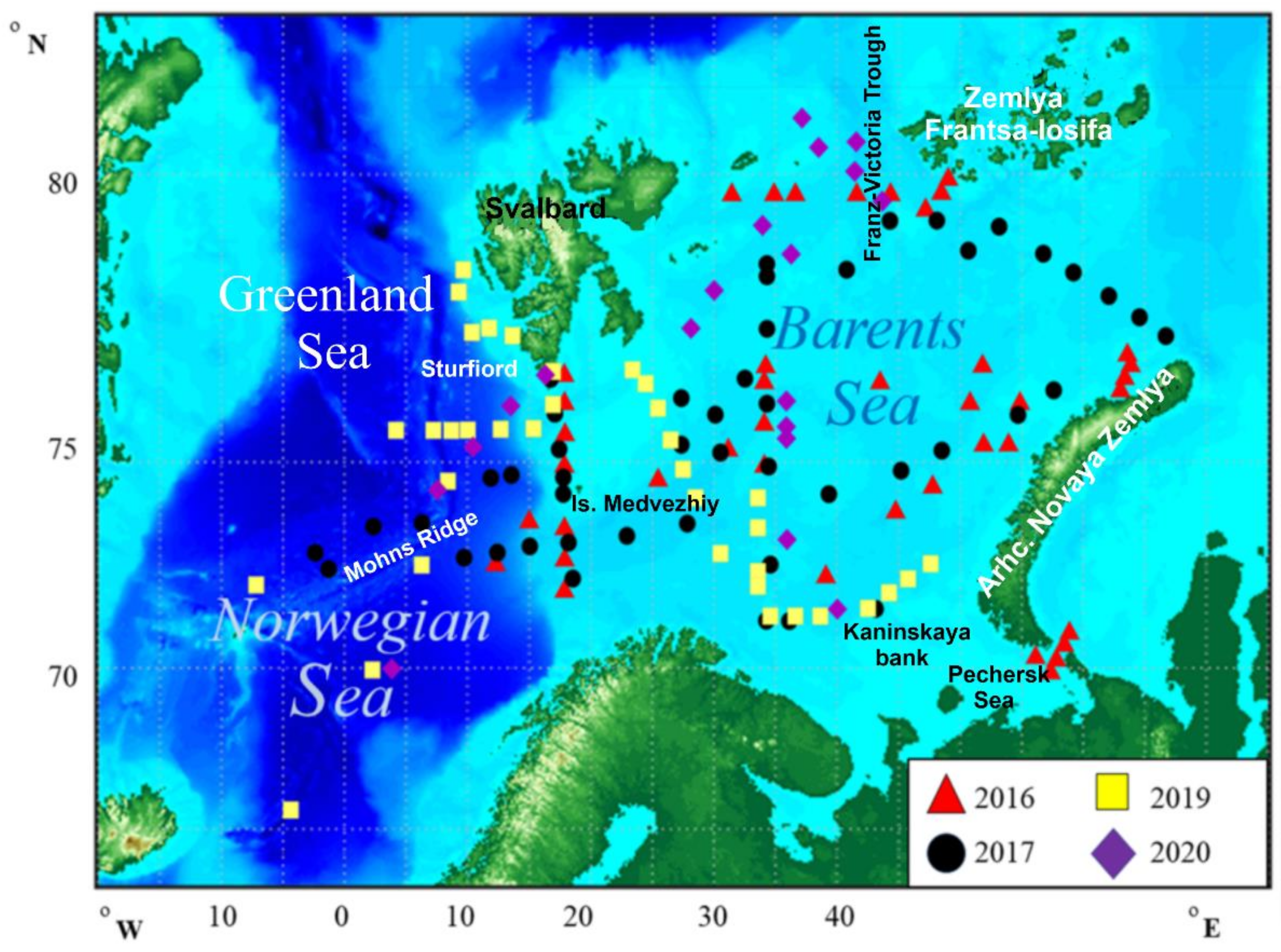
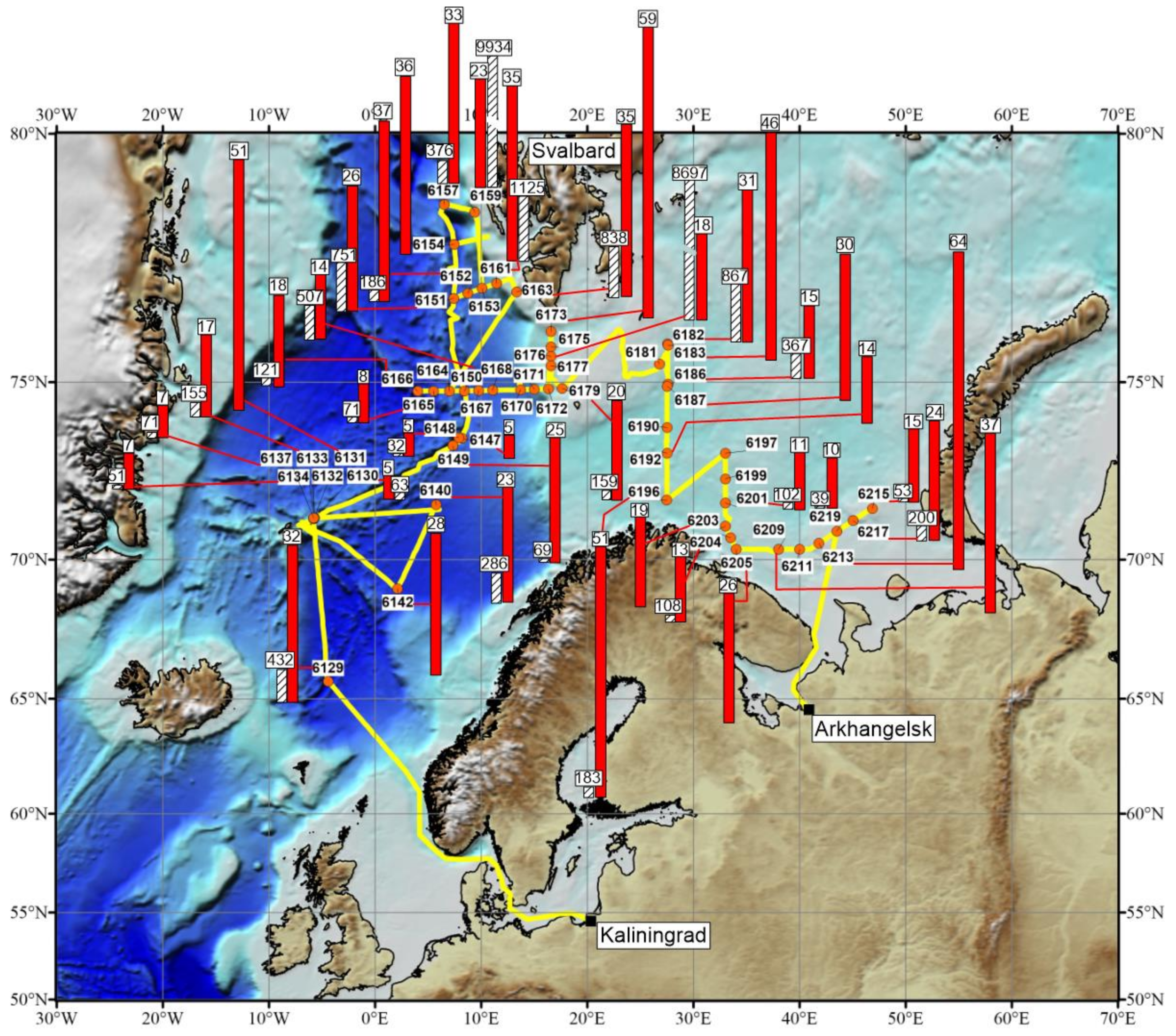
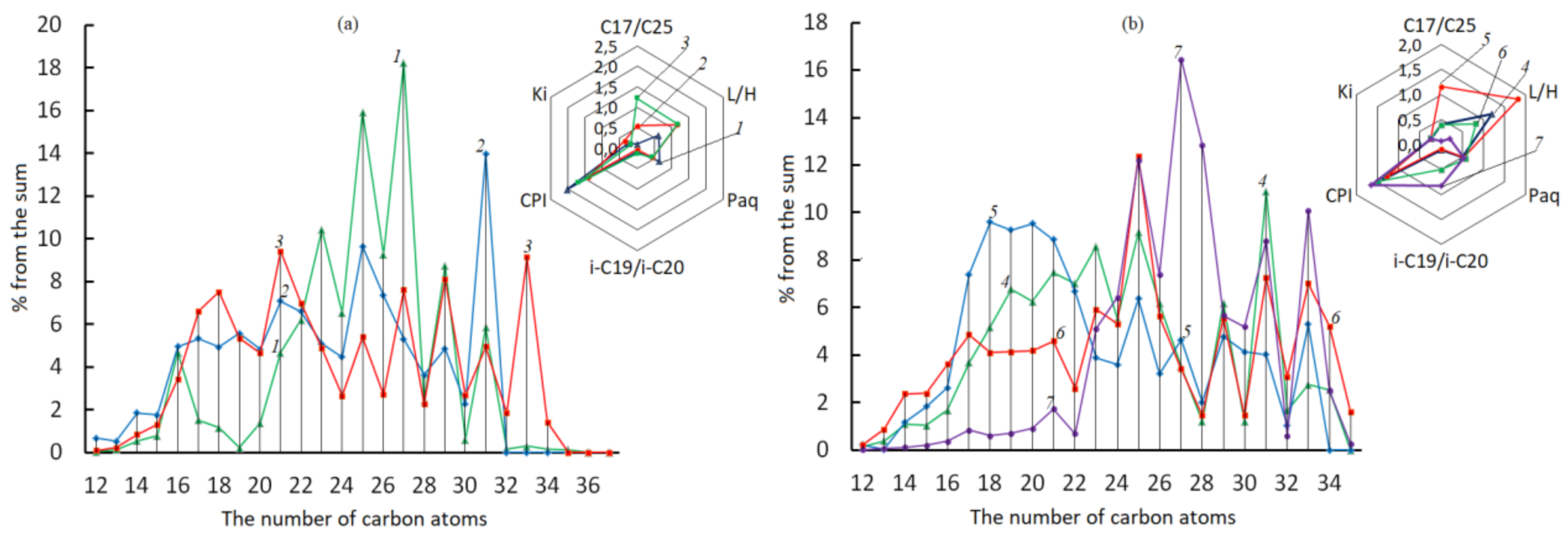
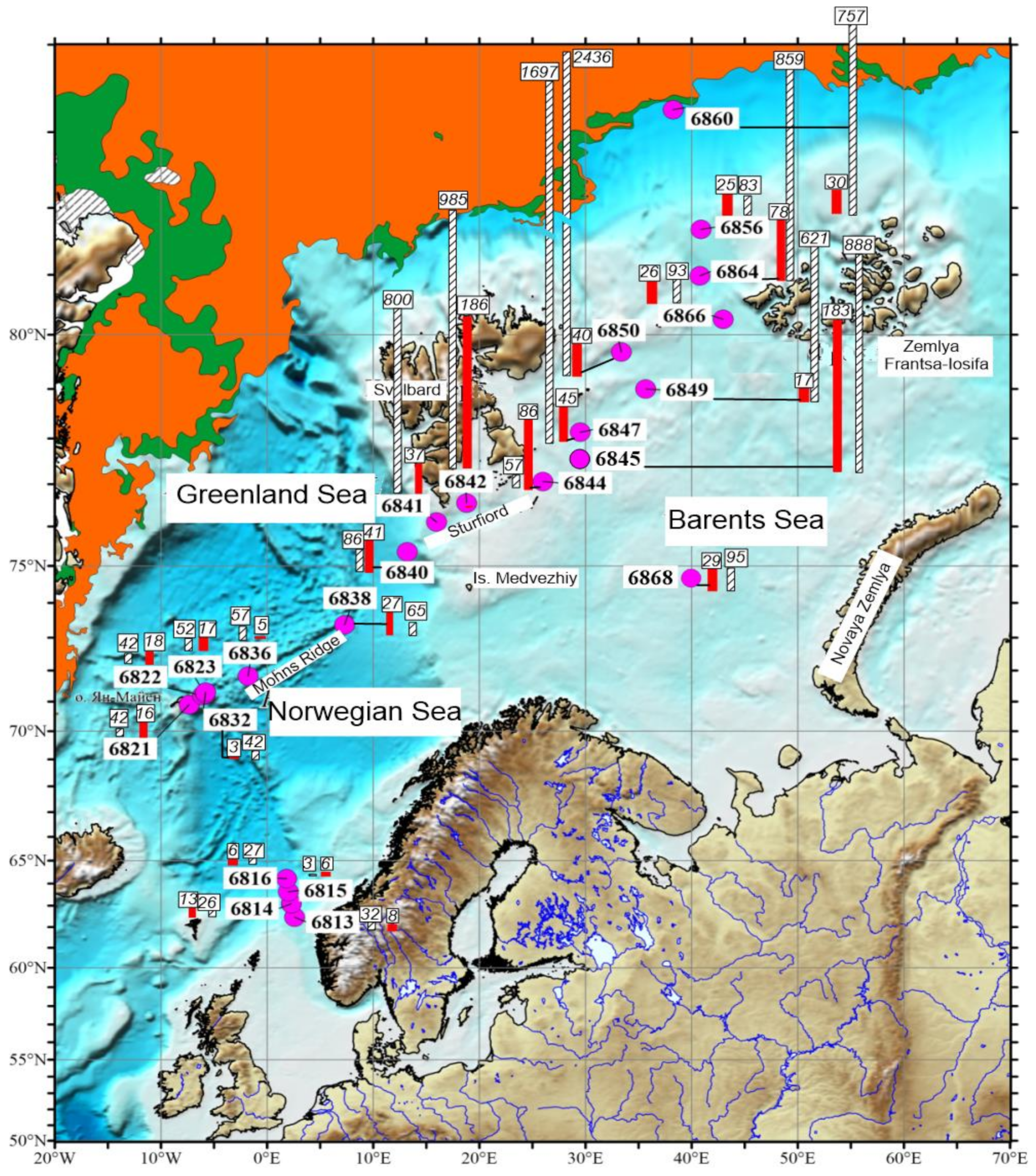
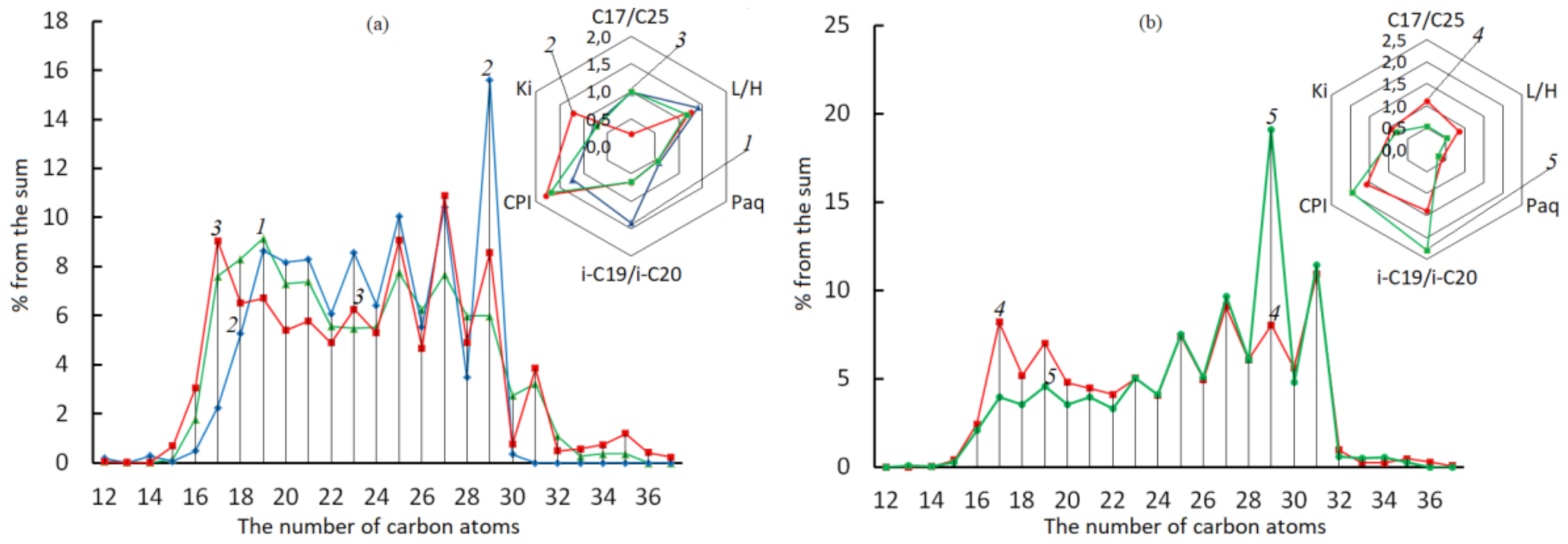

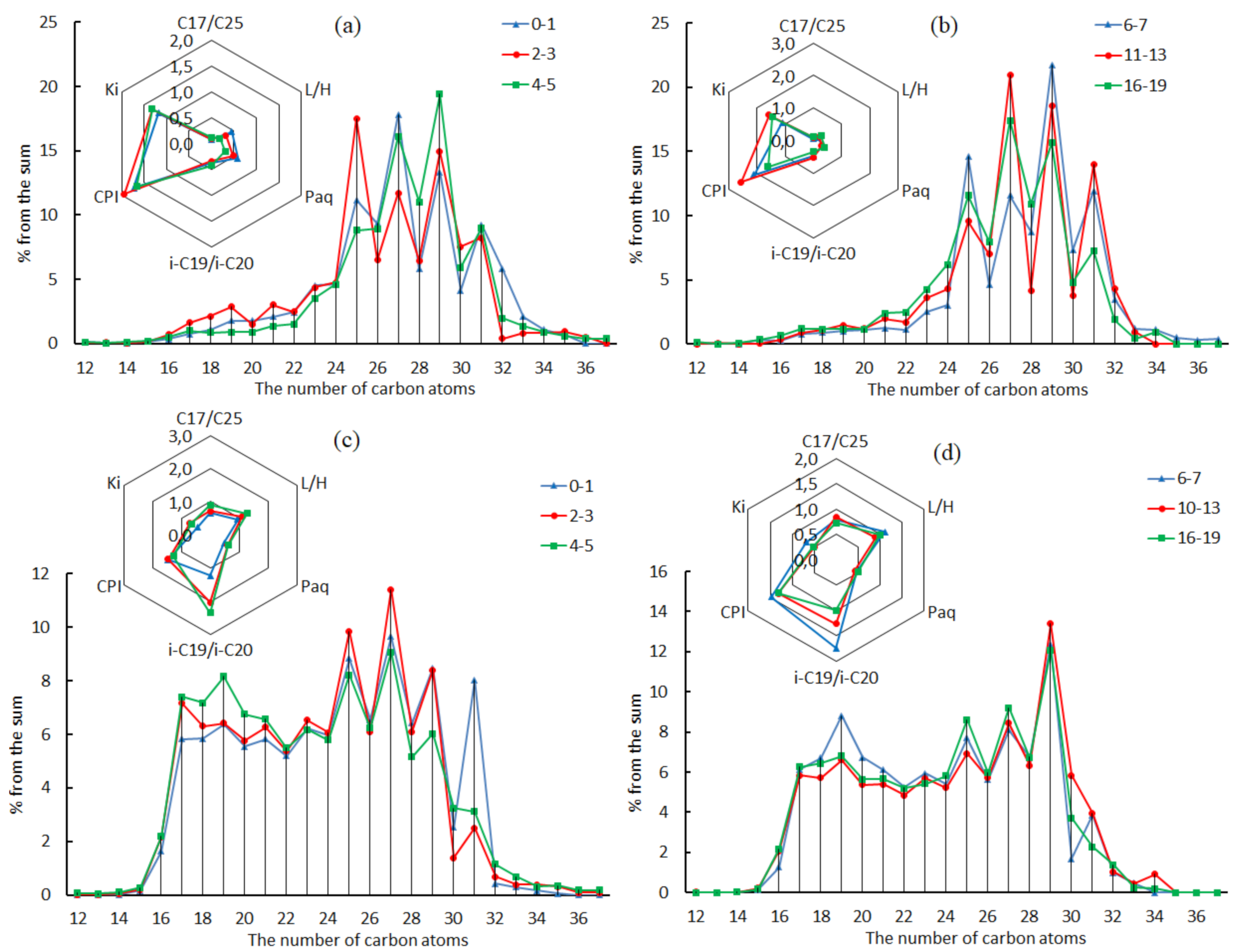

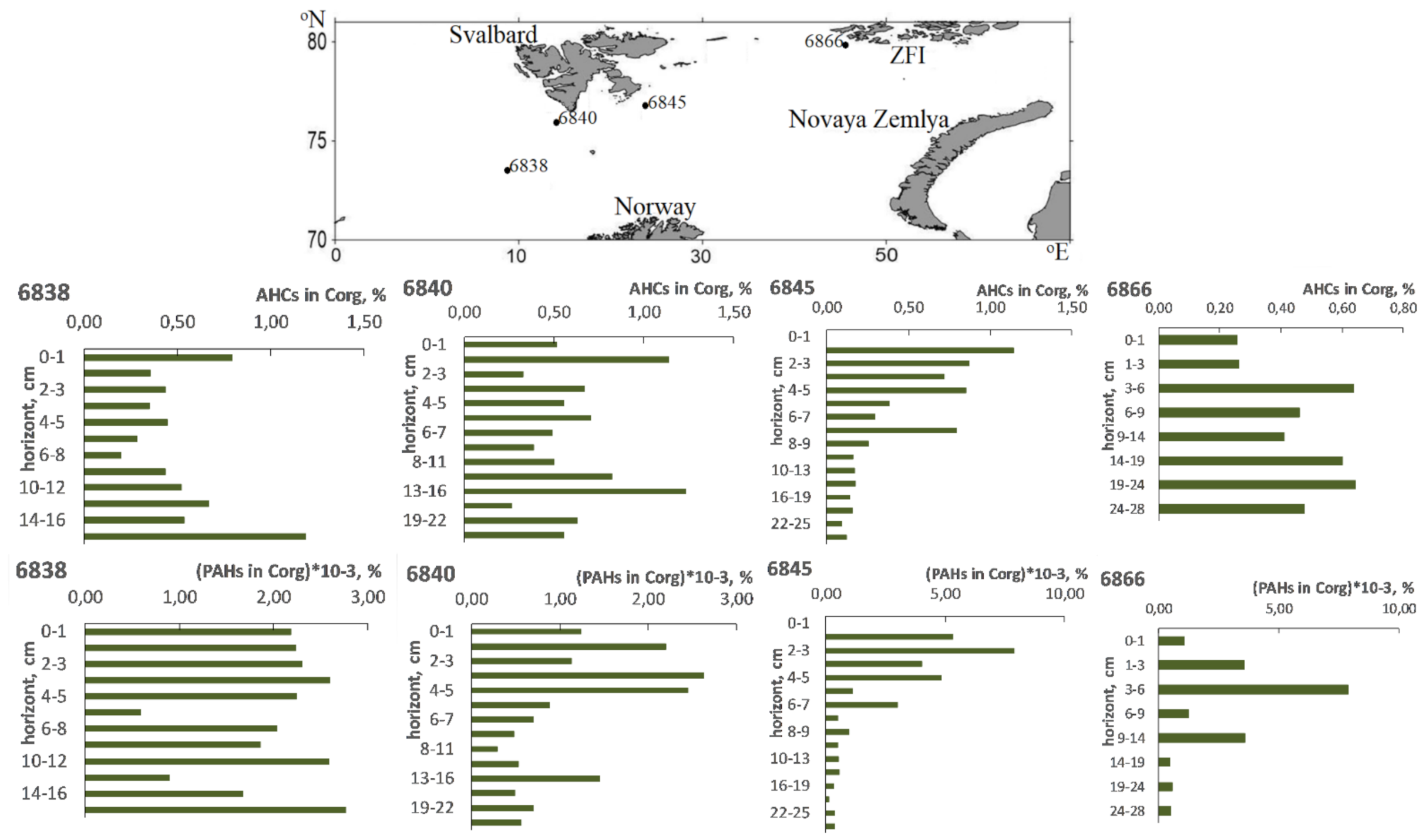
Publisher’s Note: MDPI stays neutral with regard to jurisdictional claims in published maps and institutional affiliations. |
© 2021 by the authors. Licensee MDPI, Basel, Switzerland. This article is an open access article distributed under the terms and conditions of the Creative Commons Attribution (CC BY) license (https://creativecommons.org/licenses/by/4.0/).
Share and Cite
Nemirovskaya, I.A.; Khramtsova, A.V. Features of the Hydrocarbon Distribution in the Bottom Sediments of the Norwegian and Barents Seas. Fluids 2021, 6, 456. https://doi.org/10.3390/fluids6120456
Nemirovskaya IA, Khramtsova AV. Features of the Hydrocarbon Distribution in the Bottom Sediments of the Norwegian and Barents Seas. Fluids. 2021; 6(12):456. https://doi.org/10.3390/fluids6120456
Chicago/Turabian StyleNemirovskaya, Inna A., and Anastasia V. Khramtsova. 2021. "Features of the Hydrocarbon Distribution in the Bottom Sediments of the Norwegian and Barents Seas" Fluids 6, no. 12: 456. https://doi.org/10.3390/fluids6120456





